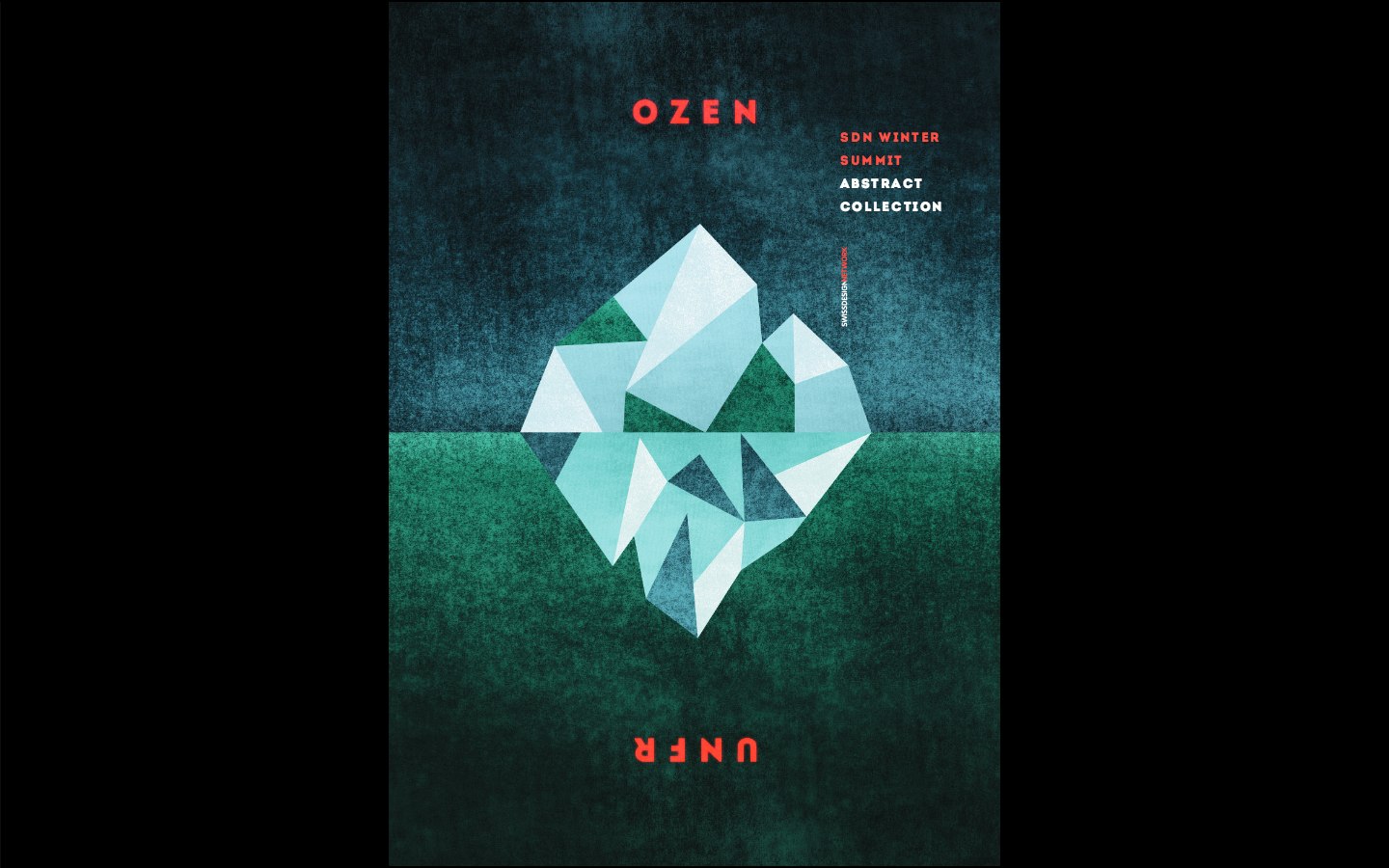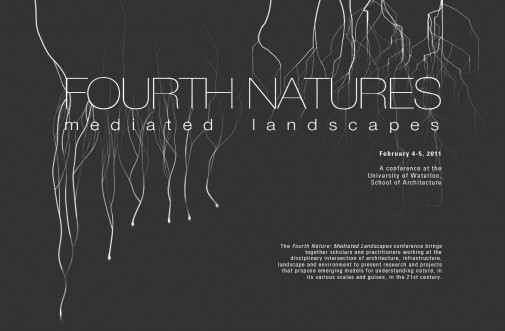Wednesday, February 24. 2016
(Big) Data sur la RTS, RTS website (Lausanne, 2016) | #entretien #détournements
Note: j'aurai le plaisir d'être en entretien --en français-- ce vendredi 26.02 à 20h avec le journaliste Frédéric Pfyffer, de la Radio Télévision Suisse Romande, dans le cadre du programme Histoire Vivante qui traite cette semaine du sujet des "Big Data".
Cet entretien, qui a été enregistré en fin de semaine passée, nous verra évoquer la façon dont les artistes ou designers abordent aujourd'hui --mais aussi un peu hier-- cette question des données. En contrepoint ou complément peut-être des approches scientifiques. Pour ma part, aussi bien dans le contexte de ma pratique indépendante (fabric | ch où de nombreux projets réalisés ou en développement s'appuient sur des données) qu'académique (projet de recherche interdisciplinaire en cours autour des "nuages"... entre autres).
À noter encore qu'au terme de la semaine d'émissions thématiques sera diffusé sur la TSR (dimanche 28.02) le documentaire Citizenfour, qui relate toute l'aventure d'Edward Snowden et du journaliste Glenn Greenwald.
Ces cinq émissions seront également disponibles en mode podcast à la même adresse, suite à la diffusion de cette semaine.
Via RTS
-----
Une semaine d’Histoire Vivante consacrée à l’histoire de la recherche scientifique à la lumière de l’émergence de l’internet et des big data.
-
Dimanche 28 février 2016, vous pouvez découvrir sur RTS Deux: CitizenFour, un documentaire de Laura Poitras (Allemagne-USA/2014):
"Citizenfour est le pseudonyme utilisé par Edward Snowden pour contacter la réalisatrice de ce documentaire lorsqu'il décide de révéler les méthodes de surveillance de la NSA. Accompagnée d'un journaliste d'investigation, elle le rejoint dans une chambre d'hôtel à Hong Kong. La suite est un huis-clos digne des meilleurs thrillers."
Thursday, January 28. 2016
I&IC at Unfrozen – Swiss Design Network 2016 Conference, SDN (Zürich, 2016)) | #datacenter #infrastructures #research
Note: I'll move this afternoon to Grandhotel Giessbach (sounds like a Wes Anderson movie) to present later tonight the temporary results of the research I'm jointly leading with Nicolas Nova for ECAL & HEAD - Genève, in partnership with EPFL-ECAL Lab & EPFL: Inhabiting and Interfacing the Cloud(s). Looking forward to meet the Swiss design research community (mainly) at the hotel...
Via iiclouds.org
-----
Christophe Guignard and myself will have the pleasure to present the temporary results of the design research Inhabiting & Interfacing the Cloud(s) next Thursday (28.01.2016) at the Swiss Design Network conference.
The conference will happen at Grandhotel Giessbach over the lake Brienz, where we'll focus on the research process fully articulated around the practice of design (with the participation of students in the case of I&IC) and the process of project.
This will apparently happen between "dinner" and "bar", as we'll present a "Fireside Talk" at 9pm. Can't wait to do and see that...
The full program and proceedings (pdf) of the conference can be accessed HERE.
As for previous events, we'll try to make a short "follow up" on this documentary blog after the event.
Friday, October 02. 2015
I&IC at Renewable Futures Conference in Riga | #thinking #speculation #futures
Via iiclouds.org
-----
The design research Inhabiting and Interfacing the Cloud(s) will be presented during the peer reviewed Renewable Futures Conference next week in Riga (Estonia), which will be the first edition of a serie that promiss to scout for radical approaches.
Christophe Guignard will introduce the participants to the stakes and the progresses of our ongoing experimental work. There will be profiled and inspiring speakers such as Lev Manovitch, John Thackara, Andreas Brockmann, etc.
Christophe Guignard will make a short “follow up” about the conference on this blog once he’ll be back from Riga.
Tuesday, September 10. 2013
fabric | ch at Close, Closer - Lisbon Architecture Triennale
By fabric | ch
-----
We are glad to announce that we'll be taking part with an Associated Project to the next Lisbon Architecture Triennale (Close, Closer, cur. Beatrice Galilee) that will take place between September 12 and December 15, 2013.
.jpg)
Img: I-Weather as Deep Space Public Lighting, fabric | ch, 2010 01SJ, San Jose.
Project:
The work we'll present with fabric | ch, in collaboration with TASML, will be in fact a call for projects (!): Deterritorialized Living (the Beijing sessions) / Inhabiting the Computer Cabinet. It follows the residency and the work we produced in Beijing last Summer at the Tsinghua University. The call is open to the international community as well as specifically to the Tsinghua University (two different dedicated awards).
We will also present two talks. On the 21st of September, I'll present this call, some related projects by fabric | ch and the results of our residency in Beijing at the LX Factory (CoworkLisboa, 103 Rua Rodrigues Faria, PIso 4). On the 14th of December, we'll present along with TASML the results of the call, with a presentation by the winning entry from China.
Dates:
30.08. - Competition launch. Tsinghua University, Beijing
21.09. 5pm - Talk by fabric | ch: Deterritorialized Living. At the LX Factory, Lisbon
14.10. Competition submissions deadline, Beijing
01.11. Announcement of winning entries
14.12., 5pm - Talk by the winner of the competition, along with fabric | ch & TASML. At the LX Factory, Lisbon
Call: http://call.deterritorialized.org
Program in Lisbon: http://beijing.deterritorialized.org/
Close, Closer: http://www.close-closer.com/en/
Monday, June 17. 2013
Alive 2013
An interesting conference that will take place at the ETHZ CAAD department next July that I'm fowarding here:
---------------
Via DARCH - ETHZ
By Manuel Kretzer
Dear friends, colleagues and students,
I'm happy to invite you to join us for the - international symposium on adaptive architecture
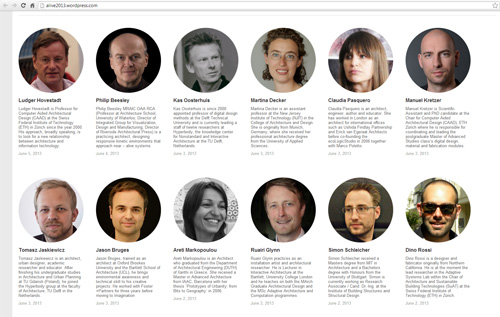
The full day event will be take place on July 8th, 2013 / 9:00 - 18:00 at the Chair for Computer Aided Architectural Design ETH Zürich-Hönggerberg, HPZ Floor F.
Speakers include: Prof. Ludger Hovestadt (ETH Zürich, CH) | Prof. Philip Beesley (University of Waterloo, CA) | Prof. Kas Oosterhuis (TU Delft, NL) Martina Decker (DeckerYeadon, US) | Claudia Pasquero (ecoLogicStudio, UK) | Manuel Kretzer (ETH Zürich, CH) Tomasz Jaskiewicz (TU Delft, NL) | Jason Bruges (Jason Bruges Studio, UK) | Areti Markopoulou (IAAC, ES) | Ruairi Glynn (UCL, UK) Simon Schleicher (Universität Stuttgart, DE) | John Sarik (Columbia University, US) | Stefan Dulman (Hive Systems, NL)
More info on the speakers, the detailed program, location and registration can be found on the event's website and the attached flyer. www.alive2013.wordpress.com
The symposium is free of charge however registration until July 3rd, 2013 is obligatory. Seats are limited. http://alive13.eventbrite.com
The event is organised by Manuel Kretzer and Tomasz Jaskiewicz, hosted by the Chair for CAAD and supported through the Swiss National Science Foundation.
Friday, April 26. 2013
Resonate Festival
Via DomusWeb
-----
By Roberto Arista
With its second edition, the Serbian festival – a meeting point for technology and art – establishes itself as a sounding board for a mature and growing scene.
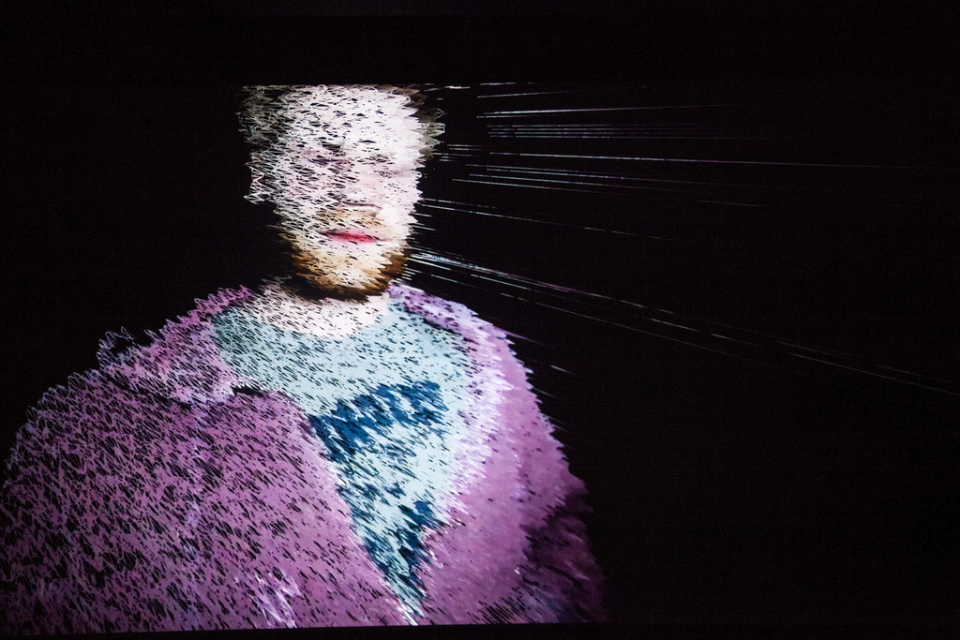
Resonate Festival, Belgrade, 2013. Projection during the debate with Memo Akten, Rainer Kohlberger, Eno Henze and Shane Walter.
Resonate was founded in 2012 by Magnetic Field B and the Creative Applications network, in an attempt to provide the visual arts world with a new platform for discussion. The event focuses on the role of technology in art and culture, and especially on the connections between the disciplines that these areas involve. The 2013 edition took place from March 21 to 23 in the Dom Omladine cultural space, close to the city’s Republic Square. More than 1200 visitors attended the event, which was already sold out several days before the opening.
The first day was devoted to a rich and varied assortment of workshops – open to all selected participants – regarding the analysis of the available tools (hardware and software) for video mapping, data visualization on different media, the design of cross-platform applications, or even the choreography of (flying) drones.
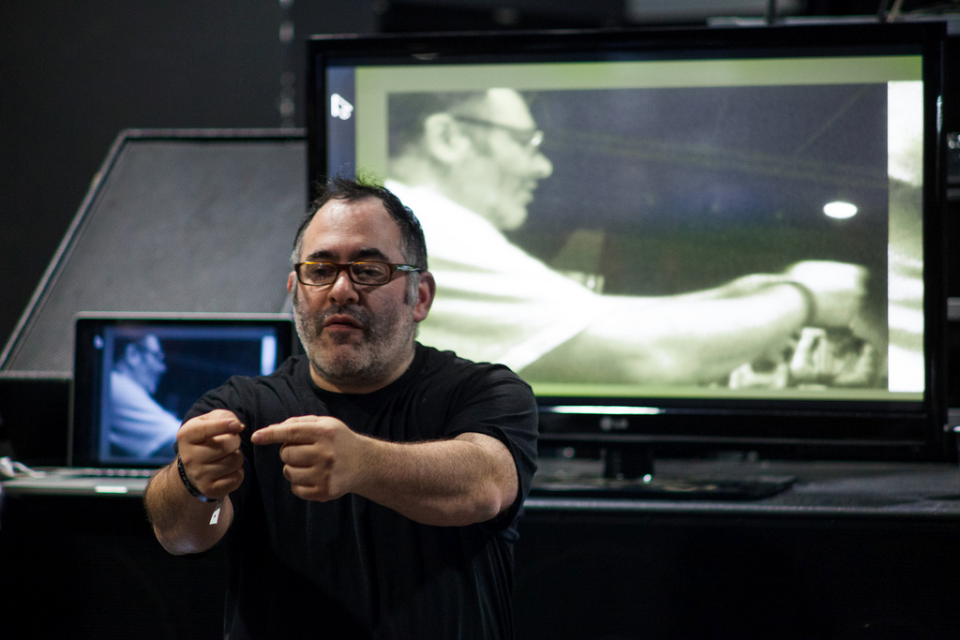
Golan Levin during the “Computer vision in interactive arts” workshop. Photo courtesy of Resonate
The next two days were dedicated to a full program of 44 lectures and video projections. The general impression is that there is a panorama of versatile designers who can carefully hybridise different disciplines and tools – marrying electronic engineering with products, landscape with graphics, analogical techniques with digital media. These designers are bolstered by the freedom to experiment that distinguishes those who are not pigeonholed within a specific category. The profession’s evolution and, more generally, a look at the recent past, were leitmotifs of some of the most interesting projects presented. Examples range from Memo Akten, Golan Levin and Joachim Sauter, who are now ready to offer an engaging retrospective of their projects, to the much admired by the public Meet your creator, Free Universal Construction Kit and Kinetic Sculpture.
The audience in the main room at Dom Omladine during the festival. Photo courtesy of Resonate
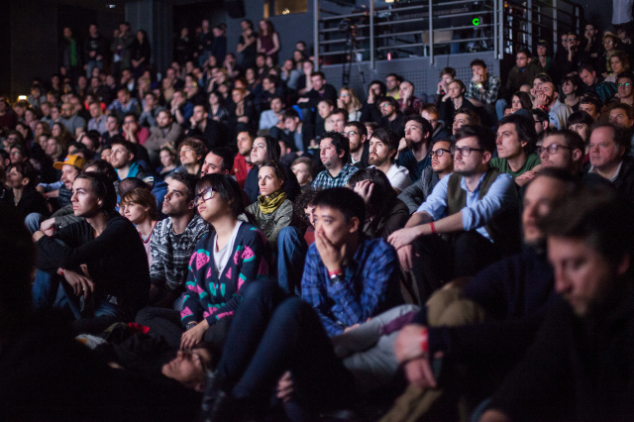
Similarly, a lively debate followed the talk by artist and interaction designer Zach Gage. Is it possible that the "game" – understood within a broader realm than the videogame – has not yet found the right place to be preserved, celebrated and narrated?
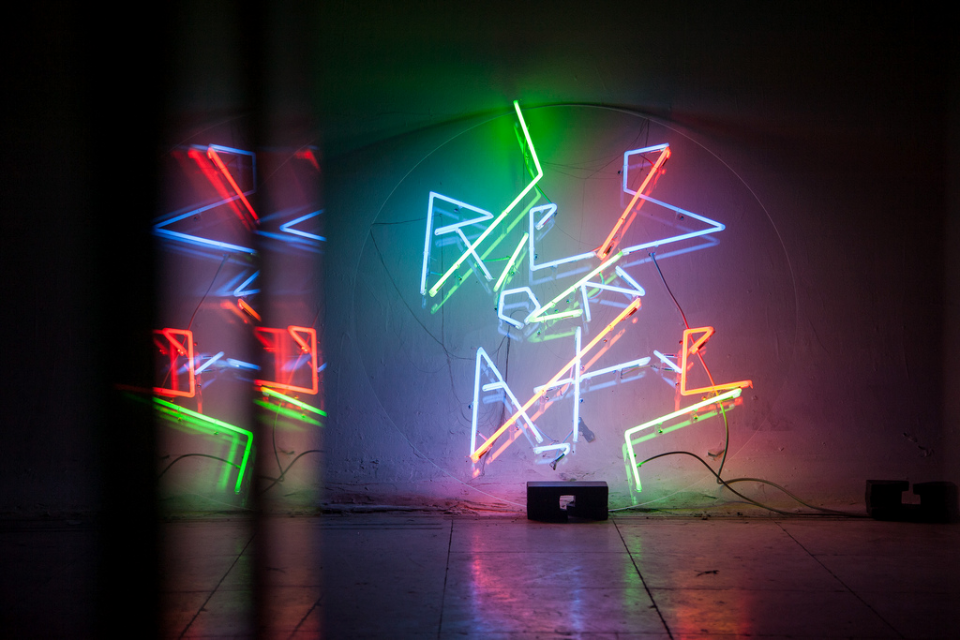
A view of the Building Kluz, where many of the festival's performances took place. Photo courtesy of Resonate
Participants were moved by London-based architect, critic and curator Liam Young’s future scenarios and landscape mutations. Projects like Silent Spring dampened that blind faith in technological advancement that permeated the festival. The work by professors in Europe’s most popular Interaction Design courses was of great interest, in particular Anthony Dunne from the RCA in London, David Gauthier from CIID in Copenhagen and Alain Bellet from ECAL in Lausanne. These schools have overcome the unnecessary separation between the humanistic and scientific universes, while in Italy the legacy left behind by Benedetto Croce still paralyses many university courses.
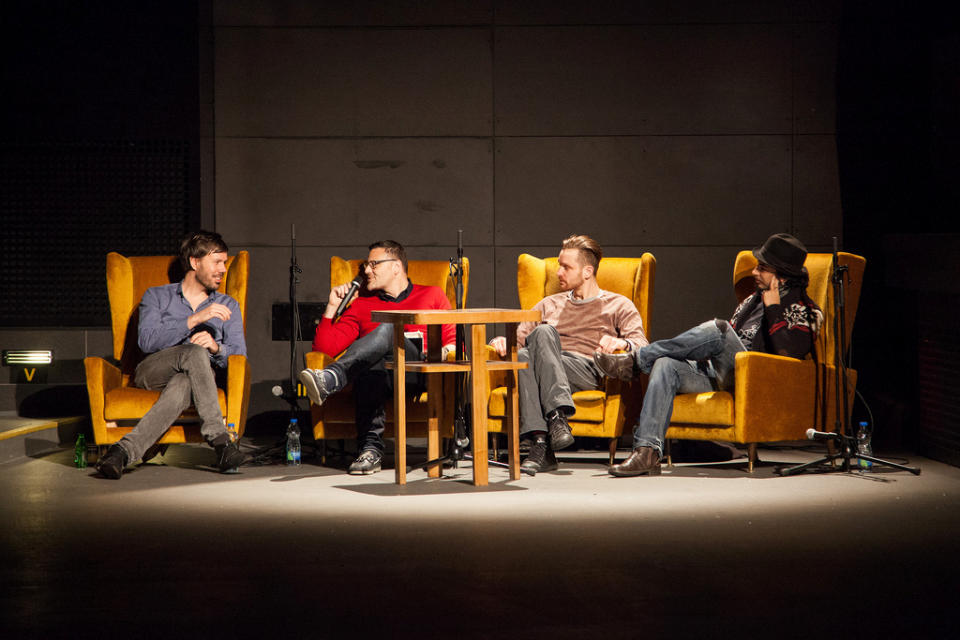
Debate participants during the second day of the festival: Memo Akten, Rainer Kohlberger, Eno Henze and Shane Walter. Photo courtesy of Resonate
It is striking that there were no Italian presenters given the number of European speakers. This is probably due to the Italian design world’s reluctance to accept the digital sphere. However, some undisputed masters were mentioned: Luigi Serafini, whose Codex Seraphinianus has become an international case study, or Bruno Munari’s work in design teaching.
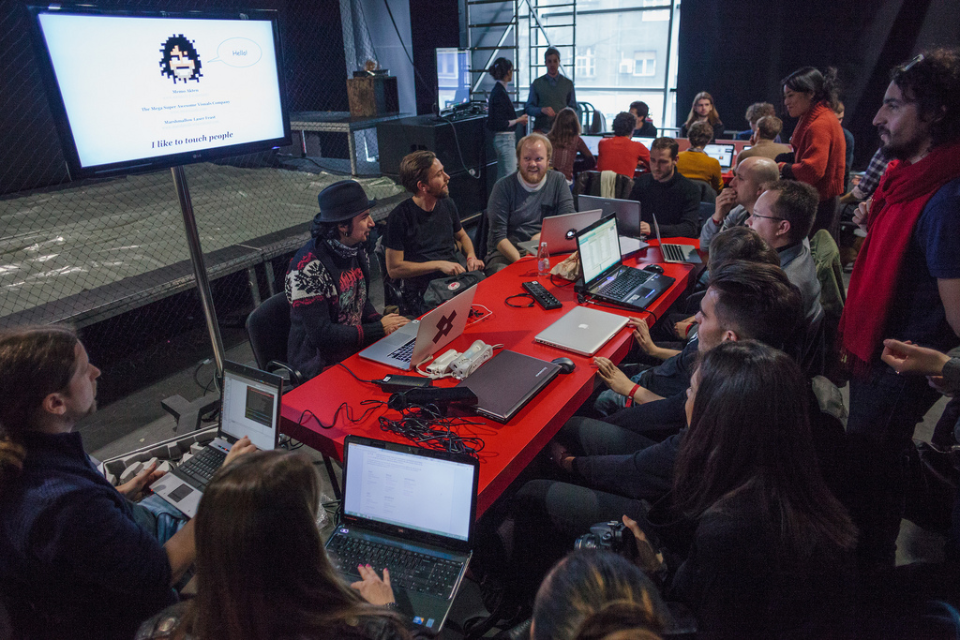
A view of Memo Atken's "How I learnt to stop worrying and love the drones" workshop. Photo courtesy of Resonate.
It became evident that childlike curiosity is fundamental in developing languages and tools. Many festival speakers dared to compare their more mature projects with images from their childhoods, so it is no coincidence that a statement by Carl Sagan’s was heard several times during the festival: "Every kid starts out as a natural-born scientist, and then we beat it out of them. A few trickle through the system with their wonder and enthusiasm for science intact." Roberto Arista
Related Links:
Personal comment:
A little report by Roberto Arista on Domusweb about the last and good Resonate conference that happened in Belgrade last March. With the talk of Alain Bellet that is head of the very good bachelor in Interaction Design at the ECAL, in Lausanne Switzerland (and occasionally, my "boss" too, as I'm teaching there as well)!
Tuesday, September 20. 2011
Wikihouse
Via Beatrice Galilee & The Gopher Hole
-----
Dear friends,
The first event of The Gopher Gala will be the story of WikiHouse, one of the most innovative global open source architecture projects today.
WikiHouse is an open community construction set. Its aim is to make it possible for almost anyone, regardless of their formal skills, to freely download and build structures which are affordable and suited to their needs. There is no single design, or single designer. Houses and components are designed by an open community of designers and users, of which you are invited to be a member. The presentation by architecture00:/ will include speakers from other open source design projects. The discussion will be chaired by Chris Foges, editor of Architecture Today.
Doors open at 6.30pm, tickets are free, there will be drinks and gala-themed party food! Reserve your seat: rsvp@holygopher.com
Architecture00:/
Architecture 00:/ is an architecture and strategic design practice based in London, whose work explores an expanded field of activity for design. Many of their projects test new kinds of social production and involve intense collaboration with innovators from other disciplines.
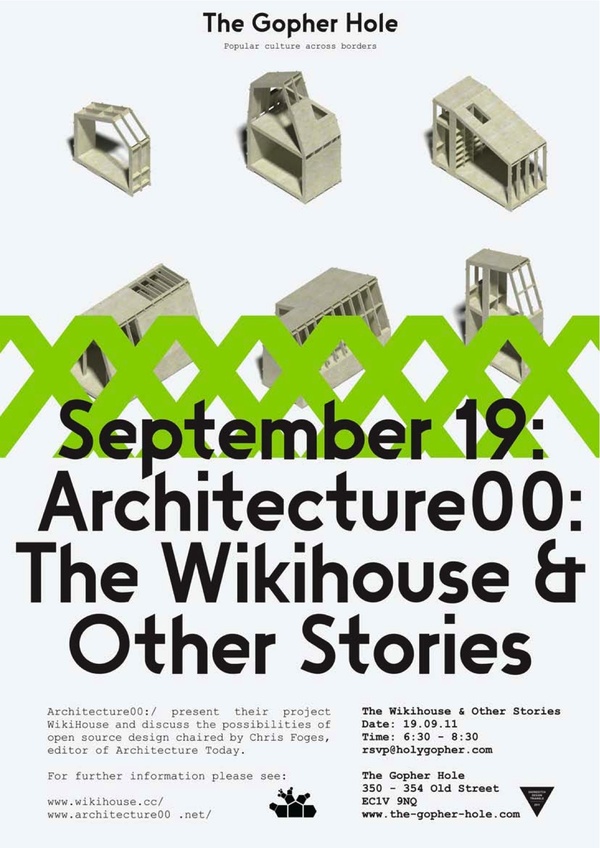
The Gopher Hole is an architecture, art, music, design, literature & miscellaneous culturegallery/venue in Hoxton.A collaboration between aberrant architecture and Beatrice Galilee, our agenda is to explore new waysof curating ideas in popular culture and to provide a forum forcritical debate on the arts and society.The Gopher Hole is part of ElPaso, a bar, workplace and dinerlocated in Shoreditch in East London.
The Gopher Gala is a week long event as part of Shoreditch Design Triangle which is promoting young design and projects in London. It ispart of a rolling programme of exhibitions, events, talks andscreenings that we hope will provide an open house for ideas that cross cultural boundaries, promote political and sociological thinking and encourage debate and exchange between disciplines.
Monday 19th‘The Wikihouse & Other Stories’ Architecture00:/ present their project WikiHouse and discuss the possibilities of open sourcedesign. Chaired by Chris Foges, editor ofArchitecture Today
Tuesday 20th ‘Archive of Spatial Aesthetics’Curator Tina Di Carlo presents the Archive of Spatial Aesthetics and Praxis. ASAP aims to be the foremostcollection of spatial practice today, collecting and exhibitingarchitecture as part of a broader social, political, and aesthetic discourse.
Wednesday 21st 'Young London: The Best of 2011' ′The best projects of 2011 will be presented in an all-nightextravaganza by a score of young London design studios, includingtalks by Revital Cohen, Nelly BenHayoun, Assemble, Something & Son, The Decorators, Klassnik Corporation, Tomorrow’s Thoughts Today, Kieren Jones and Bedford Press. Music by Type Two Error. Curated by Anna Bates & The Gopher Hole.
Thursday 22nd 'Exploding China – China’s New Megacities' Talk and booklaunch’Shanghai-based multidisciplinary think Go West Project will be in London to discuss their newbookHow the City Moved to Mr Sun in conversation with Beatrice Galilee.
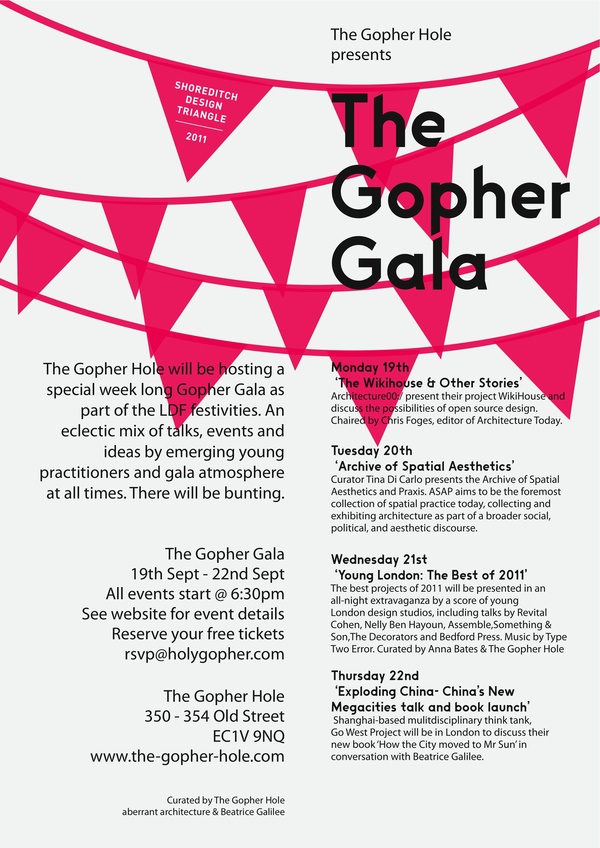
All tickets are free and events start @ 6:30pm to reserve yours please rsvp@holygopher.com
Related Links:
Personal comment:
Unfortunately the opening was yesterday, but the event goes on for the week.
Therefore more about community architecture & open source approach during this week at the promissing Gopher Hole that is run by Beatrice Galilee & aberrant architecture in Hoxton/London.
Monday, April 04. 2011
Saskia Sassen to keynote Lift France '11
Via Lift via Contemporary Spaces
-----
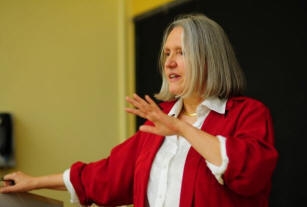
When one of the world's prominent thinker about global thinking takes a look at "smart cities", the result differs from what most of the Industry tends to say - and that's why we like it:
"I have long thought that all the major infrastructures in a city—from sewage to electricity and broadband—should be encased in transparent walls and floors at certain crossroads, such as bus stops or public squares. If you can actually see it all, you can get engaged. Today, when walls are pregnant with software, why not make this visible? (...) The challenge for intelligent cities is to urbanize the technologies they deploy, to make them responsive and available to the people whose lives they affect. Today, the tendency is to make them invisible, hiding them beneath platforms or behind walls—hence putting them in command rather than in dialogue with users. One effect will be to reduce the possibility that intelligent cities can promote open-source urbanism, and that is a pity. It will cut their lives short. They will become obsolete sooner. Urbanizing these intelligent cities would help them live longer because they would be open systems, subject to ongoing changes and innovations. After all, that ability to adapt is how our good old cities have outlived the rise and fall of kingdoms, republics, and corporations."
Cities are the places where Lift France '11's five key topics (OPEN, CARE, GREEN, LEARN, SLOW) will congregate. We're therefore especially happy that Saskia Sassen has agreed to give the opening speech.
Related Links:
Monday, March 14. 2011
Workshop: Pervasive Urban Applications, 12 June 2011, San Francisco
Via The Mobile City
-----
by admin
The First Workshop on Pervasive Urban Applications (PURBA) will take place in conjunction with the Ninth International Conference on Pervasive Computing in San Francisco, CA, USA on June 12-15, 2011.
Over the past decade, the development of digital networks and operations has produced an unprecedented wealth of information. Handheld electronics, location devices, telecommunications networks, and a wide assortment of tags and sensors are constantly producing a rich stream of data reflecting various aspects of urban life. For urban planners and designers, these accumulations of digital traces are valuable sources of data in capturing the pulse of the city in an astonishing degree of temporal and spatial detail. Yet this condition of the hybrid city – which operates simultaneously in the digital and physical realms – also poses difficult questions about privacy, scale, and design, among many others. These questions must be addressed as we move toward achieving an augmented, fine-grained understanding of how the city functions – socially, economically and yes, even psychologically.
This workshop aims to bring together researchers and practitioners to discuss and explore the research challenges and opportunities in applying the pervasive computing paradigm to urban spaces. We are seeking multi-disciplinary contributions that reveal interesting aspects about urban life and exploit the digital traces to create novel urban applications that benefit citizens, urban planners, and policy makers.
Organizers:
- Francesco Calabrese, MIT
- Santi Phithakkitnukoon, MIT
- Dominik Dahlem, MIT
- Giusy Di Lorenzo, MIT
Related Links:
Tuesday, February 01. 2011
Fourth Natures: Mediated Landscapes
InfraNet Lab is pleased to announce that we will be hosting a conference entitled ‘Fourth Nature: Mediated Landscapes’ at the University of Waterloo, School of Architecture, in Cambridge, ON, this Friday, Feb. 4th and Saturday, Feb. 5th. The conference brings together scholars and practitioners working at the disciplinary intersection of architecture, infrastructure, landscape and environment to present research and projects that propose emerging models for understanding ‘nature’, in its various scales and guises, in the 21st century. From the territorial to the nano-scale, mutant environments which fuse natural and artificial, technologic and infrastructural have been proliferating. Natures are monitored and controlled, ecologies are amplified or manufactured and interior landscapes are conditioned, with the intent of augmenting performance, controlling the flow of resources, monitoring data or redressing environmental imbalances. In the current scenario, the dialectic is no longer nature versus city, or natural versus artificial, but positions within a spectrum of mediation and manipulation of nature, landscape and built environment.
Speakers include:
Keynote
François Roche (R&Sie(n))
Fourth Natures: New Contexts
Cary Wolfe (Rice University, Series Editor of Posthumanities )
Alessandra Ponte (Universite de Montreal)
Christine Macy (Dalhousie University)
Andy Payne (University of Toronto) (Moderator)
Fourth Natures: New Disciplines
Lydia Kallipoliti (Cooper Union, Columbia University, Director of Ecoredux)
John J. May (UCLA and University of Toronto, Millions of Moving Parts)
John McMinn (University of Waterloo) ( Moderator)
Fourth Natures: New Practices
Martin Felsen (Illinois Institute of Technology, Archeworks, Director of UrbanLab)
Janette Kim ( Columbia University, Director of Urban Landscape Lab)
Sean Lally (University of Illinois at Chicago, Director of WEATHERS)
Liat Margolis (University of Toronto) ( Moderator)
Detailed information about the conference schedule and speakers can be found at: http://www.architecture.uwaterloo.ca/fourthnatures/
fabric | rblg
This blog is the survey website of fabric | ch - studio for architecture, interaction and research.
We curate and reblog articles, researches, writings, exhibitions and projects that we notice and find interesting during our everyday practice and readings.
Most articles concern the intertwined fields of architecture, territory, art, interaction design, thinking and science. From time to time, we also publish documentation about our own work and research, immersed among these related resources and inspirations.
This website is used by fabric | ch as archive, references and resources. It is shared with all those interested in the same topics as we are, in the hope that they will also find valuable references and content in it.
Quicksearch
Categories
Calendar
|
|
July '25 | |||||
| Mon | Tue | Wed | Thu | Fri | Sat | Sun |
| 1 | 2 | 3 | 4 | 5 | 6 | |
| 7 | 8 | 9 | 10 | 11 | 12 | 13 |
| 14 | 15 | 16 | 17 | 18 | 19 | 20 |
| 21 | 22 | 23 | 24 | 25 | 26 | 27 |
| 28 | 29 | 30 | 31 | |||

